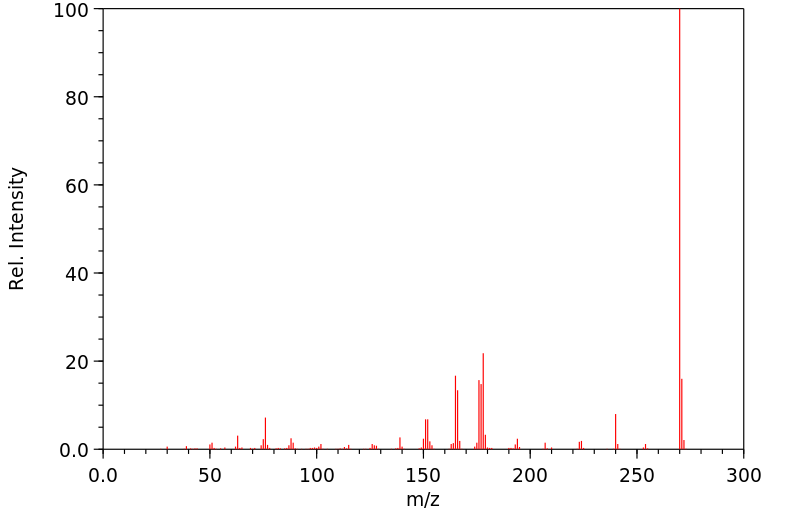(Z)-4,4'-dinitrostilbene | 619-93-2
中文名称
——
中文别名
——
英文名称
(Z)-4,4'-dinitrostilbene
英文别名
1,2-bis(4-nitrophenyl)ethylene;4,4'-dinitro-cis-stilbene;cis-4,4'-dinitrostilbene;Z-4,4'-dinitrostilbene;cis-1,2-bis-(4-nitro-phenyl)-ethene;4,4'-dinitro-cis-stilbene;1-nitro-4-[(Z)-2-(4-nitrophenyl)ethenyl]benzene
CAS
619-93-2
化学式
C14H10N2O4
mdl
——
分子量
270.244
InChiKey
CLVIIRIMEIEKOQ-UPHRSURJSA-N
BEILSTEIN
——
EINECS
——
-
物化性质
-
计算性质
-
ADMET
-
安全信息
-
SDS
-
制备方法与用途
-
上下游信息
-
文献信息
-
表征谱图
-
同类化合物
-
相关功能分类
-
相关结构分类
物化性质
-
沸点:413.36°C (rough estimate)
-
密度:1.2809 (rough estimate)
计算性质
-
辛醇/水分配系数(LogP):3.8
-
重原子数:20
-
可旋转键数:2
-
环数:2.0
-
sp3杂化的碳原子比例:0.0
-
拓扑面积:91.6
-
氢给体数:0
-
氢受体数:4
安全信息
-
海关编码:2904209090
SDS
上下游信息
-
上游原料
中文名称 英文名称 CAS号 化学式 分子量 —— trans-4,4'-dinitrostilbene 736-31-2 C14H10N2O4 270.244 4-硝基苄基碘化物 4-nitrobenzyl iodide 3145-86-6 C7H6INO2 263.035 对硝基苯甲醛 4-nitrobenzaldehdye 555-16-8 C7H5NO3 151.122 对硝基溴化苄 1-bromomethyl-4-nitro-benzene 100-11-8 C7H6BrNO2 216.034 1-(氯甲基)-4-硝基苯 4-nitrobenzyl chloride 100-14-1 C7H6ClNO2 171.583 对硝基苯乙酸 4-nitrobenzeneacetic acid 104-03-0 C8H7NO4 181.148 —— 2,3t-bis-(4-nitro-phenyl)-acrylic acid 6277-62-9 C15H10N2O6 314.254 —— 2,3-bis-(4-nitro-phenyl)-acrylic acid 6277-62-9 C15H10N2O6 314.254 -
下游产品
中文名称 英文名称 CAS号 化学式 分子量 —— trans-4,4'-dinitrostilbene 736-31-2 C14H10N2O4 270.244 (E)-4-(对氨基苯)乙烯 (E)-4,4'-diaminostilbene 7314-06-9 C14H14N2 210.279 —— cis-stilbene-4,4'-diyldiamine 34321-29-4 C14H14N2 210.279
反应信息
-
作为反应物:描述:(Z)-4,4'-dinitrostilbene 在 tetrabutylammonium tetrafluoroborate 作用下, 以 N,N-二甲基甲酰胺 为溶剂, 以89%的产率得到trans-4,4'-dinitrostilbene参考文献:名称:从4-硝基甲苯和4,4'-二硝基联苄到E -4,4'-二硝基苯乙烯:电化学方法摘要:通过Z -O 2 NC 6 H 4 CH CHC 6 H 4 NO 2,E -O 2 NC 6 H 4 CH CHC 6 H 4 NO 2,O 2 NC 6 H 4 CH 2 -CH 2的电还原形成的阴离子。C 6 H 4 NO 2或O 2 NC 6 H 4 CMeH–CMeHC 6 H在循环伏安法(DMF + 0.10 M NBu 4 BF 4)的时间范围内, 4 NO 2以及由4-硝基甲苯产生的阴离子自由基是稳定的。但是,在电解时间范围内(从几分钟到几小时),只有二价阴离子O 2 NC 6 H 4 CMeH–CMeHC 6 H 4 NO 2 2-保持稳定,因为还原的物质Z -O 2 NC 6 H 4 CHCHC 6 H 4 NO 2 2-,O 2 NC 6 H4 CH 2 -CH 2 C ^ 6 ħ 4 NO 2 2-或O的2 NC 6 H ^ 4 ME - ,进化以形成ë -O 2 NCDOI:10.1039/c8nj00131f
-
作为产物:描述:参考文献:名称:甲苯胺和脱氧安息香染料。19.关于偶氮染料及其中间体的交流摘要:DOI:10.1002/hlca.19380210107
文献信息
-
Gelation Ability of Novel Oxamide-Based Derivatives Bearing a Stilbene as a Photo-Responsive Unit作者:Snežana Miljanić、Leo Frkanec、Zlatko Meić、Mladen ŽinićDOI:10.1002/ejoc.200500535日期:2006.3various organic solvents. In contrast, cis-3a shows a poor gelation ability or none at all, owing to its good solubility. Considering the difference in gelation abilities of the compounds trans-3a and cis-3a and the photo-responsive conformational changes of the stilbene part of the molecule, a controlled gelation by light was achieved. FT-IR and 1H NMR spectroscopic measurements support the view that hydrogen已经合成了包含一个或两个与顺式和反式二苯乙烯的 4- 或 4,4'- 位偶联的草酰胺部分的草酰胺衍生物。为了调节溶剂的凝胶化趋势,由它们制备了一系列具有修饰末端官能团的衍生物。发现基于反式茋二草酰胺的衍生物微溶于或不溶于水和有机溶剂,而基于反式茋单草酰胺的衍生物可溶于大多数有机溶剂。在后一种化合物的结构中引入 C12 烷基链会导致溶解度降低,但会增加物质的凝胶化趋势。乙酯草酰胺基衍生物反式3a和氨基酸草酰胺基衍生物反式3e作为各种有机溶剂的有效凝胶剂。相比之下,由于其良好的溶解性,cis-3a 显示出较差的凝胶化能力或根本没有凝胶化能力。考虑到化合物 trans-3a 和 cis-3a 胶凝能力的差异以及分子二苯乙烯部分的光响应构象变化,实现了光控胶凝。FT-IR 和 1H NMR 光谱测量支持草酰胺片段之间的氢键在凝胶形成中起重要作用的观点。(© Wiley-VCH Verlag GmbH
-
Aqueous Wittig Reactions of Aldehydes with In Situ Formed Semistabilized Phosphorus Ylides作者:Jinlong Wu、Dan Li、Da ZhangDOI:10.1080/00397910500213054日期:2005.10Abstract The Wittig reactions of three semistabilized phosphorus ylides generated in situ from the corresponding phosphonium salts with aldehydes in water without any organic cosolvent were investigated. Most of the olefination reactions completed within between 5 min and 4.5 h in refluxing water containing 1.5 equiv of LiOH and 1.4 M LiCl to afford the products in 65–100% yields. The E∶Z selectivity
-
3,5-Bis(trifluoromethyl)phenyl Sulfones in the Direct Julia−Kocienski Olefination作者:Diego A. Alonso、Mónica Fuensanta、Carmen Nájera、Montserrat VareaDOI:10.1021/jo050852n日期:2005.8.1sulfones, giving poorer results. Methylenation of aliphatic and aromatic aldehydes, ketones, and 1,2-dicarbonyl compounds is carried out through the modified Julia olefination using BTFP methyl sulfone 7d to give terminal alkenes and dienes. Mechanistic studies of the olefination reaction between benzyl BTFP sulfone 7a and aromatic aldehydes performed by KOH-induced Smiles rearrangement of stereodefined syn-3,5-双(三氟甲基)苯基(BTFP)砜7已用于与羰基化合物的Julia-Kocienski烯化反应中。砜7易于通过烷基化/氧化两步法从市售3,5-双(三氟甲基)苯硫酚中高产率(64-97%)制备。已经研究了金属化BTFP砜的稳定性并将其与杂芳基苯并噻唑-2-基(BT),1-苯基-1 H-四唑-5-基(PT)和1-叔丁基-1 H-四唑- -5-基(TBT)砜9 - 11不同的反应条件下。烷基BTFP砜之间的Julia-Kocienski烯烃7各种各样的醛以良好的收率和立体选择性提供相应的1,2-二取代的烯烃和二烯。可以在室温下使用KOH或在-78°C或室温下使用磷腈碱P2-Et和P4- t - Bu进行此一锅操作规程,已成功用于各种甲氧基化对苯二酚的高产率和立体选择性合成中如三甲基化白藜芦醇。Julia-Kocienski烯烃化反应的这些新反应条件也已用BT,PT和TBT砜进行了研究,但结果较差。脂族和芳族醛,酮和1
-
Surface photochemistry: exergonic and endergonic photocatalysed reaction in the CdS-mediated cis–trans-isomerization of cis-4-substituted stilbenes作者:Tadashi Hasegawa、Paul de MayoDOI:10.1039/c39850001534日期:——The cis-stibenes (1a–g) undergo photocatalysed cis-trans-isomerization on CdS; the Hammett plot for the reaction has a sharp break at σ+=–0.19 [E°½= 1.47 V vs. standard calomel electrode] and is rationalized in terms of both exergonic and endergonic photocatalysed processes on the semiconductor with different rate-determining steps.
-
Experimental Evidence for Multiple Oxidation Pathways in the (salen)Mn-Catalyzed Epoxidation of Alkenes作者:Christian Linde、Nordine Koliaï、Per-Ola Norrby、Björn ÅkermarkDOI:10.1002/1521-3765(20020603)8:11<2568::aid-chem2568>3.0.co;2-z日期:2002.6.3the catalytic epoxidation of para-substituted cis stilbenes 2a-i were investigated by using (R,R)-[N,N'-bis(3,5-di-tBu-salicylidene)-1,2-cyclohexanediamine]manganese(III) chloride 1 in benzene as the catalyst with iodosobenzene as the terminal oxidant. A Hammett study of the selectivity results reveals a stronger electrophilic character than previously assumed in the (salen)Mn-catalyzed reaction. In使用(R,R)-[N,N'-bis(3,5-di-tBu-Salicylidene)-1研究了底物电子对对位取代的顺式斯蒂尔苯酯2a-i催化环氧化反应选择性的影响1,2-环己烷二胺]氯化锰(III)1在苯中作为催化剂,碘代苯作为末端氧化剂。Hammett对选择性结果的研究表明,其亲电特性比以前在(salen)Mn催化的反应中所假定的要强。通常,通过使用Hammett sigma +值获得与实验值的最佳相关性,对于顺式环氧形成速率,rho = -1.37;对于逐步反应的逐步过程速率,rho = -0.43。反产品。该反应涉及两个单独的途径,这也由中间体在甲氧基取代的底物的反式环氧化物的竞争性竞争中表明。对于4-甲氧基-4'-亚硝基二苯乙烯而言,导致顺式环氧化物的协同途径中的异步性是显而易见的,由于电子效应,其完全产生具有75%ee的顺式环氧化物。
表征谱图
-
氢谱1HNMR
-
质谱MS
-
碳谱13CNMR
-
红外IR
-
拉曼Raman
-
峰位数据
-
峰位匹配
-
表征信息
同类化合物
(E,Z)-他莫昔芬N-β-D-葡糖醛酸
(E/Z)-他莫昔芬-d5
(4S,5R)-4,5-二苯基-1,2,3-恶噻唑烷-2,2-二氧化物-3-羧酸叔丁酯
(4S,4''S,5R,5''R)-2,2''-(1-甲基亚乙基)双[4,5-二氢-4,5-二苯基恶唑]
(4R,5S)-4,5-二苯基-1,2,3-恶噻唑烷-2,2-二氧化物-3-羧酸叔丁酯
(4R,4''R,5S,5''S)-2,2''-(1-甲基亚乙基)双[4,5-二氢-4,5-二苯基恶唑]
(1R,2R)-2-(二苯基膦基)-1,2-二苯基乙胺
鼓槌石斛素
黄子囊素
高黄绿酸
顺式白藜芦醇三甲醚
顺式白藜芦醇
顺式己烯雌酚
顺式-白藜芦醇3-O-beta-D-葡糖苷酸
顺式-桑皮苷A
顺式-曲札芪苷
顺式-二苯乙烯
顺式-beta-羟基他莫昔芬
顺式-a-羟基他莫昔芬
顺式-3,4',5-三甲氧基-3'-羟基二苯乙烯
顺式-1-(3-甲基-2-萘基)-2-(2-萘基)乙烯
顺式-1,2-双(三甲基硅氧基)-1,2-双(4-溴苯基)环丙烷
顺式-1,2-二苯基环丁烷
顺-均二苯乙烯硼酸二乙醇胺酯
顺-4-硝基二苯乙烯
顺-1-异丙基-2,3-二苯基氮丙啶
非洲李(PRUNUSAFRICANA)树皮提取物
阿非昔芬
阿里可拉唑
阿那曲唑二聚体
阿托伐他汀环氧四氢呋喃
阿托伐他汀环氧乙烷杂质
阿托伐他汀环(氟苯基)钠盐杂质
阿托伐他汀环(氟苯基)烯丙基酯
阿托伐他汀杂质D
阿托伐他汀杂质94
阿托伐他汀杂质7
阿托伐他汀杂质5
阿托伐他汀内酰胺钠盐杂质
阿托伐他汀中间体M4
阿奈库碘铵
锌(II)(苯甲醛)(四苯基卟啉)
银松素
铜酸盐(5-),[m-[2-[2-[1-[4-[2-[4-[[4-[[4-[2-[4-[4-[2-[2-(羧基-kO)苯基]二氮烯基-kN1]-4,5-二氢-3-甲基-5-(羰基-kO)-1H-吡唑-1-基]-2-硫代苯基]乙烯基]-3-硫代苯基]氨基]-6-(苯基氨基)-1,3,5-三嗪-2-基]氨基]-2-硫代苯基]乙烯基]-3-硫代
铒(III) 离子载体 I
铀,二(二苯基甲酮)四碘-
钾钠2,2'-[(E)-1,2-乙烯二基]二[5-({4-苯胺基-6-[(2-羟基乙基)氨基]-1,3,5-三嗪-2-基}氨基)苯磺酸酯](1:1:1)
钠{4-[氧代(苯基)乙酰基]苯基}甲烷磺酸酯
钠;[2-甲氧基-5-[2-(3,4,5-三甲氧基苯基)乙基]苯基]硫酸盐
钠4-氨基二苯乙烯-2-磺酸酯







